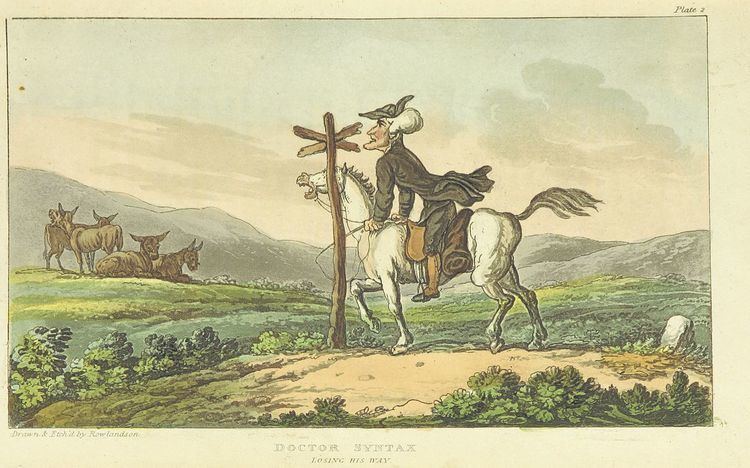Name William Combe Role Writer | ||
 | ||
Died June 19, 1823, London, United Kingdom Books The third tour of Doctor Sy, The first of April, The Tour of Doctor Syntax - in, The English Dance of, The tour of Doctor Syntax | ||
The Tour of Dr. Syntax in Search of the Picturesque (FULL Audiobook)
William Combe (25 March 1742 – 19 June 1823) was a British miscellaneous writer. His early life was that of an adventurer, his later was passed chiefly within the "rules" of the King's Bench Prison. He is chiefly remembered as the author of The Three Tours of Doctor Syntax, a comic poem, illustrated by artist Thomas Rowlandson's color plates, that satirised William Gilpin. Combe also wrote a series of imaginary letters, supposed to have been written by the second, or "wicked" Lord Lyttelton. Of a similar kind were his letters between Swift and "Stella". He also wrote the letterpress for various illustrated books, and was a general hack.
Contents
- The Tour of Dr Syntax in Search of the Picturesque FULL Audiobook
- Early life
- Works
- Translations
- References
Early life
Combe's father Robert Combes was a rich London ironmonger who died in 1756; his mother, Susannah Hill (died 1748) was from a Quaker background. He was educated at Eton College, but was withdrawn from the school by William Alexander, his guardian, on his father's death; Alexander died in 1762. He inherited from both his father and guardian, aspired to the status of gentleman, and changed his name to Combe. He spent his fortune, travelled and was nicknamed "Count Combe"; and in the period 1769–1773 was low in funds, existing in France, Wales and the West Midlands.
In 1773 Robert Berkeley employed Combe to edit Thomas Falkner's Description of Patagonia. Combe then settled to work as a writer and book editor.
Works
In 1776 Combe made his first success in London with The Diaboliad, a satire full of bitter personal attacks. Four years later, in 1780, debts brought him into the King's Bench Prison, and much of his subsequent life was spent in prison.
Combe's spurious Letters of the Late Lord Lyttelton (1780) took in many of his contemporaries: as late as 1851, a writer in the Quarterly Review regarded these letters as authentic, basing on them a claim to have solved the riddle of identity of Junius, in Thomas Lyttelton, 2nd Baron Lyttelton. An early acquaintance with Laurence Sterne resulted in Combe's anonymous Letters supposed to have been written by Yorick and Eliza (1779), the named characters being from Sterne's The Life and Opinions of Tristram Shandy, Gentleman. Periodical literature of all sorts—pamphlets, satires, burlesques, "two thousand columns for the papers," "two hundred biographies"—filled up the next years, and about 1789 Combe was receiving £200 yearly from the Pitt government as a pamphleteer.
In 1790 and 91, the six volumes of a Devil on Two Sticks in England won for Combe the title of "the English le Sage". In 1794 he ghost-wrote the Aeneas Anderson memoir of the Lord Macartney embassy to Peking, "A Narrative of the British Embassy to China, in the Years 1792, 1793, and 1794". In 1794–1796 he wrote the text for Boydell's History of the River Thames, and in 1803 he began to write for The Times. From 1809 to 1811 he wrote for Ackermann's The Poetical Magazine the serialized comic poem The Tour of Dr Syntax in Search of the Picturesque, descriptive and moralizing verse illustrated by artist Thomas Rowlandson's color plates. It satirised William Gilpin, who toured Britain to describe his theory of the Picturesque. It was collected in book form in 1812, and was followed by two similar Tours, "...in search of Consolation" (1819) and "...in search of a Wife," the first Mrs Syntax having died at the end of the first Tour. The second Tour was collected as an 1820 book, and the third tour as an 1821 book. Some reprint editions over the next several decades rendered Rowlandson's color plates in black and white.
Then came Six Poems in illustration of drawings by Princess Elizabeth (1813), The English Dance of Death (1815–1816), The Dance of Life (1816–1817), The Adventures of Johnny Quae Genus (1822)—all written for Rowlandson's caricatures; together with histories of Oxford and Cambridge, and of Westminster Abbey for Ackermann; Picturesque Tours along the Rhine and other rivers, Histories of Madeira, Antiquities of York, texts for Turner's Southern Coast Views, and contributions innumerable to the Literary Repository.
Combe died in London on 19 June 1823.
